The Heilman locomotives were the first steam-electric designs, using a reciprocating steam engines to drive DC generators, which in turn powered electric motors mounted directly on the axles.

THE BIG HEILMANNS
Two new locomotives were built, numbered 8001 and 8002, of more advanced design.
The improved design used a conventional Belpaire boiler without superheater and a much more powerful Willans high-speed vertical steam engine to drive the DC generators. 1000 kW of mechanical power was produced at 400 rpm, and each six-pole generator gave 450V at 910A, or 410 kW each. The generators could sustain a 100% overload for 15 minutes, and a 50% overload for 30 minutes. The exciter dynamo was driven by a small-cylinder engine developing 18 kW at 550 rpm; the exciting voltage was 110V and 140A was available. Only 100A was required for excitation of the main generators, the surplus being used for lighting. The electrical equipment was once again supplied by Brown Boveri & Co.
The first of the two machines made its initial test run of 115 km on 12 November 1897. The load consisted of 12 personnel and a test van, giving a total weight of 150 tonnes, and the maximum speed was restricted to 30 km/h. These tests were completed without difficulties. On later test runs the total weight was increased to 250 tonnes and speeds increased to 100km/h. The maximum speed attained was 120 km/h. The two big Heilmann locomotives clearly showed their advantages over the classical steam locomotive. The total weight was usable for the adhesion and the design gave good acceleration and traction power as well as outstandingly quiet running over the whole speed range.
The design aroused the interest of other railway networks- for a while at least. The Russian Southern railway and the Ohio River, Madison & Central railway of the USA (?) both tentatively planned the building of such locomotives. There was also interest in Germany. Nothing however came of this international attention.
A few hard facts:
Service weight | 124 tonnes
Adhesion weight | 124 tonnes
Wheel diameter | 1160 mm
Grate area | 3.34 m2
Evaporation surface | 185.5 m2
Steam pressure | 204 psi
Steam temperature | 194 degC
| | | | | | | | | | | | | |
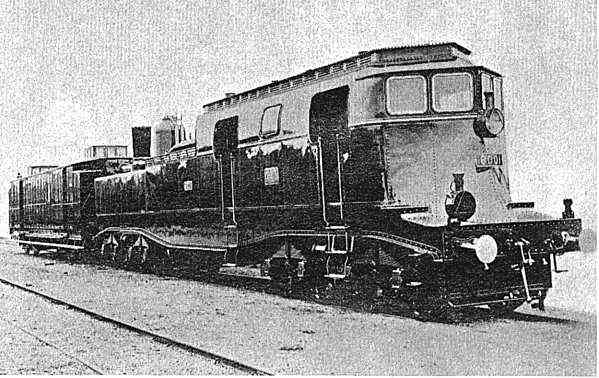 |
| Left: The Heilmann Steam-Electric locomotive. It was basically a cabforward design, but it could run in either direction.
|
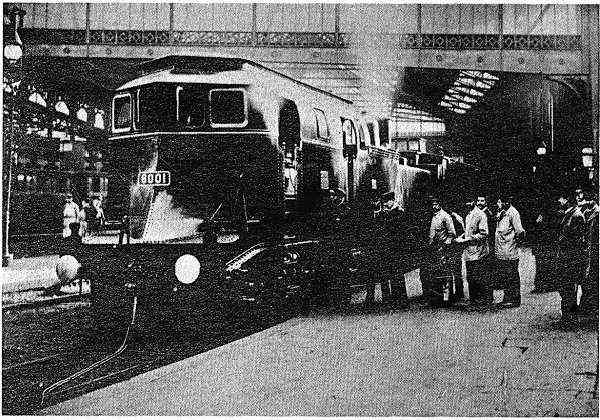 |
| Left: The Heilmann locomotive 8001 at Gare Saint-Lazare in Paris, about to set off on a test run.
|
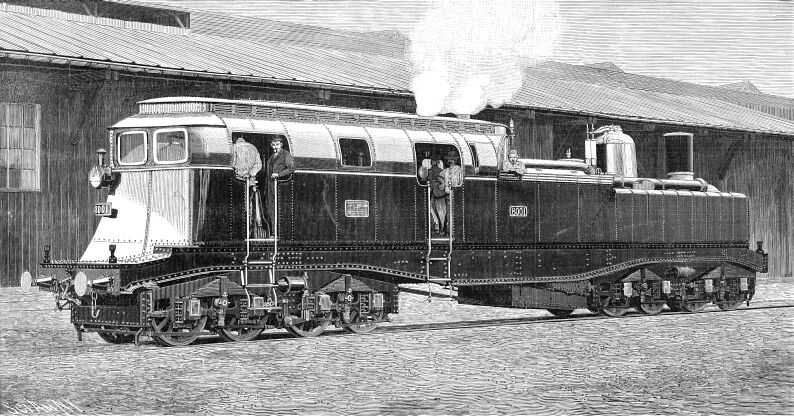 "> "> |
| Left: The Heilmann Steam-Electric locomotive
Note the man at the right standing in one of the side coal bunkers and leaning on the side. Below him the plate can just be made out to read "8001".
|
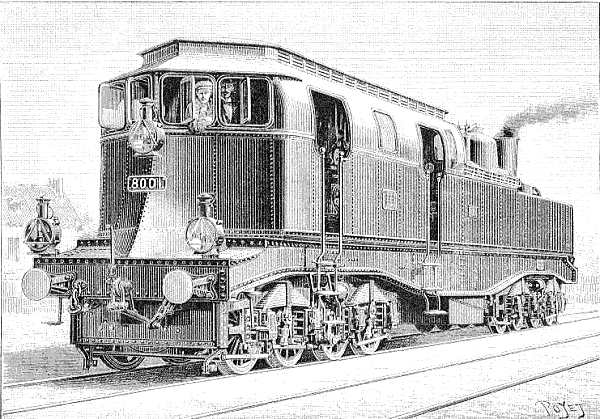 |
| Left: The Heilmann as pictured in the French scientific journal Nature.
No 8001 again. Was 8002 never photographed?
|
 |
| Left: Cutaway drawing of the Heilmann, showing the Willans engine.
There is a DC generator at each end of the engine. The small exciter engine is mounted on top of the nearest generator. The two large pipes visible at the top took the exhaust to the blastpipe.
From Nature.
|

Above: Plan view of The Heilmann. The big 6-crank Willans engine is to the left, the boiler to the far right.
The exciter engine is immediately to the right of the main engine. The long middle pipe took the steam from the regulator to the engine. The long pipes at top and bottom carried the engine exhaust back to the blastpipe in the smokebox.
 |
| Left: Side view of The Heilmann.
|

Above: Another side view, probably taken from the same original drawings.
 |
| Left: The electrical circuitry, showing eight electric motors.
This is a simplified circuit as the big Heilmanns actually had two main generators.
DC was used for ease of motor control.
|
An extract from a Scientific American article on the big Heilmann engines:
"It is now some three years since Mr. J. J. Heilmann, of Paris, designed and placed in operation his first standard gauge electric locomotive, which was known as La Fusee Electrique and was tested upon the lines of the Compagnie des Chemins de Fer de l'Ouest,of France. The Fusee was of 600 horse power and 120 tons weight and it was designed for hauling the ordinary class of passenger trains. The novelty of this locomotive consisted in the fact that it did not take its current from a feeder connecting with a distant power station, but carried its power station with it— the boiler, engine, generators, and motors being all combined in one machine upon one set of wheels and comprising an absolutely self-contained electric locomotive.
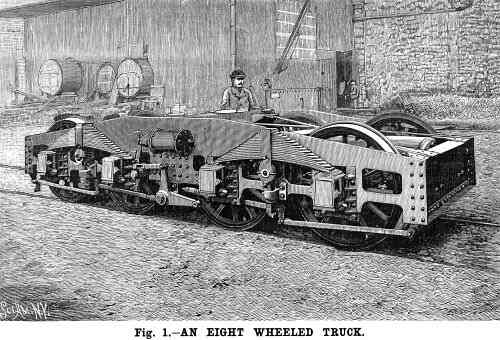 |
| "In spite of a vast amount of adverse criticism based on theoretical a priori grounds the builders of the Fusee were so well satisfied with its performance that they have constructed two more locomotives of the same type, but having much greater power and embodying the improvements suggested by the trials above referred to. By the courtesy of the builders we present a series of views of the first of these engines taken during its construction at the shops.
The designs of the Heilmann locomotive have been subjected to considerable criticism, mainly on the ground that it is at an evident disadvantage compared with the ordinary steam locomotive, because it necessitates an extra conversion of power, with its inevitable attendant loss. But while the loss in conversion is admitted, it is claimed by Mr. Heilmann that there are valuable compensations to be realized. In the first place, the absence of reciprocating parts and counterbalance weights secures a perfectly balanced engine which is easy upon the track and bridges.
|
"There is a further economy, it is contended, in the use of a many-cylindered high speed engine, and although considered as an electric motor, there is a greater weight of machinery to be carried than in a motor driven from a central station, this is offset by the absence of any loss by transmission over a line of greater or less length.
 |
| "Regarding the first claim that this type of locomotive is perfectly balanced there can be no dispute, and the designer is entitled to full credit for having solved one of the most difficult problems connected with high speed locomotives. In the ordinary type the evil effects of "excess balance" are met or mitigated by the use of large driving wheels. This, however, necessitates a slow piston speed and a corresponding reduction of the indicated horse power. In the Heilmann machine the main engine is completely balanced by the arrangement of the six cranks, and the tests which have taken place show that there is a complete absence of the well known hammering and plunging effects noticeable in the ordinary locomotive.
|
"It will be argued that the ordinary electric motor is also balanced, and that the extra load of boiler, engines and generator are a distinct handicap to this engine. To this it must be answered that in a locomotive of 1,350 horse power, which it is claimed the new machines will develop, the load of boiler, engines, etc., is almost necessary to give the requisite adhesion when the locomotive is working up to full power, as in starting or on a steep grade.It is evident that in proportion as the weight of the steam boiler, engines and generators become necessary for adhesion, the advantages of their installation in a separate power house disappear.
"The above facts show that the design is per se not so altogether indefensible as many of its critics have roundly declared; and the aims of its designers appear yet more reasonable when they state that in building the Heilmann locomotive an effort is being made to make it possible to equip the trunk railroads electrically, without making any radical changes in the road itself. With this fact in view, it must be admitted that whether the arguments above given are sound or not, this machine will enable the railroad companies to experiment with electric traction on a limited scale without undertaking the great expense which will be entailed in the use of the central station system.
"The machine is built upon a pair of deep plate girders and carried by a couple of eight-wheel trucks, one under each end. The total length of the engine over all is 61 feet and the rigid wheel base measures 37 feet 3 inches. The front of the engine is not, as one would suppose from looking at the engraving, the end occupied by the boiler, the latter being placed over the rear trucks, the forward half of the platform carrying the engines, generators, exciters, etc. Water is carried in two tanks, one on each side of the boiler, and the coal bunkers are situated just ahead of the tanks and on each side of the fire box. The engines, generators, etc., are completely housed in by a large plate-steel cab or casing which is given a sharp, plow-like format its forward end with a view to reducing the air resistance.
 |
| "The boiler of the first experimental locomotive was of the Lentz type, with corrugated fire box and combustion chambers, but in the present type the designer has returned to the ordinary locomotive style of boiler, the fire boxes being, however, of copper and built on the Belpaire pattern. There are 351 tubes 1.77 inch in diameter and 12.5 feet long, and, there are 35.95 square feet of grate surface, the total heating surface of the whole boiler being 1,996.5 square feet. The boiler pressure is 200 pounds to the square inch. The generators are driven by a Willans compound six-crank vertical engine, the cranks being set at 0 degrees, 120 degrees, 240 degrees, 240 degrees, 120 degrees and 0 degrees, by which arrangement the difficulties of counterbalancing are completely overcome. In spite of its high speed, the engine runs in perfect equilibrium. As we have said, this is one respect in which Mr. Heilmann claims a distinct advantage over the ordinary form of locomotive, in which the well known counterbalance problem is causing no end of trouble and expense.
"There are two continuous current generators directly connected to the main shaft, one at each end of the engine. The generators, which were built by Messrs. Brown, Boveri & Company, are continuous machines coupled in parallel, and each has a capacity of about 1,000 amperes at 450 volts. They are excited by a small four-pole self-exciting dynamo which is driven by a simple Willans engine of about 28 horse power. The current is led to eight motors, one for each axle of the trucks. The motors have four poles, with two field cores placed horizontally.
|
"The field winding is an insulated copper strip and the armature is a toothed drum wound in series and mounted on a hollow steel shaft which carries at one end a disk. This disk transfers the motion to the axle by means of three powerful links which are carried upon three corresponding pairs of springs secured between the arms of one wheel. The arrangement is shown in Figs. 3 and 5 in the accompanying illustrations. The axle passes with sufficient clearance through the hollow shaft,and the springs have sufficient flexibility, even under the full power of the motor, to allow free movement of the hollow shaft. The motors are all connected in parallel and each motor is fed by a special circuit from the switchboard and has its own switch and automatic cutout. For low speed and under heavy loads the motors may be grouped in a series of four by means of a controller. There is an eight-way switch for reversing the current in the armatures of the motors and for instantaneously changing their direction. The speed may be varied by means of a rheostat placed in the exciting circuit of the generators.
 |
| "The controlling gear is arranged in duplicate, one set being placed at the forward end of the locomotive and the other near the boiler in the position usually occupied by the throttle and reversing lever in an ordinary locomotive. This is done to enable the engine to run in either direction. It is claimed by the makers that these locomotives will take a train of nearly 400 tons at a speed of 62 miles an hour. We are informed that the preliminary trials, of which we do not as yet possess the details, give reason to expect that when they are in active service these locomotives will be capable of performing the full duty for which they are designed."
|
The big Heilmanns were in many ways a success, but no more were built. It was complex and expensive, and heavy for the power it generated. One serious disadvantage was that it needed a crew of three; a driver, a fireman, and a "pilote électricien" to manage the electrical system; this last crewmember is rather puzzling as the electrics do not look complicated. Conventional locomotives only required two men.

MORE PICTURES OF THE BIG HEILMANNS
The dates, and in most cases the locations, of the photographs are not currently known.
 | .
| Left: Heilmann No 8001 in Paris: 1898?
A beautiful picture. No 8001 stands, at first sight in a Paris street, coupled to what appears to be a brake van, judging by the cupolas on top of it. Determining the general location of this photograph was one of the less challenging tasks faced by the staff of the Museum.
As I said a little while ago, given some old maps of Paris, it ought to be possible to work out the exact location. John Bevan tells me: "The photo of Heilmann 8001 with the Eiffel Tower in the background seems to have been taken at or near the Gare du Champs de Mars. The station was located near where the Australian Embassy is now located." This seems very likely as the line to the Gare du Champs de Mars was the only railway running near the Eiffel tower (erected 1889) at the time; it was also part of the Ouest railway network on which the Heilmanns were trialled.
|
The line was originally built to serve the 1867 Exposition Universelle. The station was demolished afterwards, but rebuilt for the 1878 Exposition Universelle. This was in turn demolished in 1894 and rebuilt for the 1900 Exposition Universelle, with the line extended to the Invalides terminus and and moved to the side of the Seine. This is quite a bizarre story in itself. In 1988 Champs de Mars became a stop on the RER C, a new suburban railway line serving the Eiffel Tower. The station is now located below the Quai Branly.
The Seine would have been to the left of this photograph. No station buildings are visible in the left background- just trees.
As well as a passenger station, in 1900 the Ouest also built a goods station between the Avenue de Suffren and the Boulevard de Grenelle, and that must be the likeliest location for the photograph; there appears to be a loading gauge in the left background. Both of these roads still exist; the Avenue de Suffren is on the south-west side of the Champ du Mars, and the Boulevard de Grenelle to the south-west of that. Until 1937, the goods station was a busy coal terminal. The site then became an EMU shed, closing in 1971. Unsurprisingly, there is no sign of a goods yard today. Its position is now occupied by the Stadium Emile Anthoine.
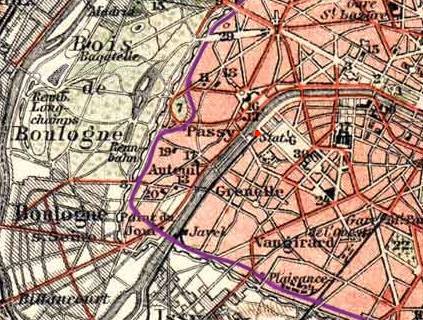 | .
| Left: The location of Gare du Champs de Mars: 1898
The station is highlighted in red. (just to the right of the word "Passy") The Eiffel tower is just to the north-east of the station. It appears that in the picture above No 8001 was standing just south-west of the station. I am trying to find a larger scale map.
The purple line is the "petite ceinture" or "little belt" a railway that ran encircled Paris just inside a line of fortifications. It was built with an eye to the rapid movement of men and material if Paris was besieged, but its main use was for freight workings. It was connected to all the main lines running into the big Paris stations.
From the 1898 Brockhaus map of Paris.
|
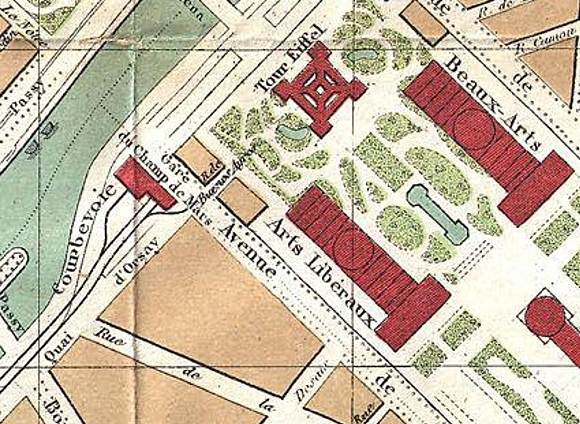 | .
| Left: The Champ du Mars station: 1892
This shows the site before the goods yard was built in 1900. The Heilmann was probably standing near where the word d'Orsay appears.
|
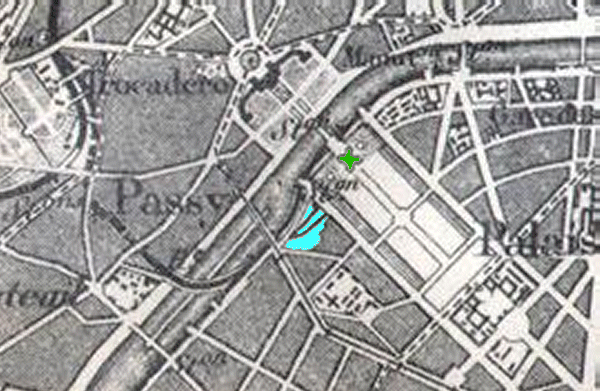 | .
| Left: The L'Ouest goods yard, marked in blue: 1902
The Eiffel tower is shaded green.
From the 1902 L'Armee Case Map of Paris and Environs. The railway bridge over the Seine seems to have been built after the 1898 map above was produced.
|
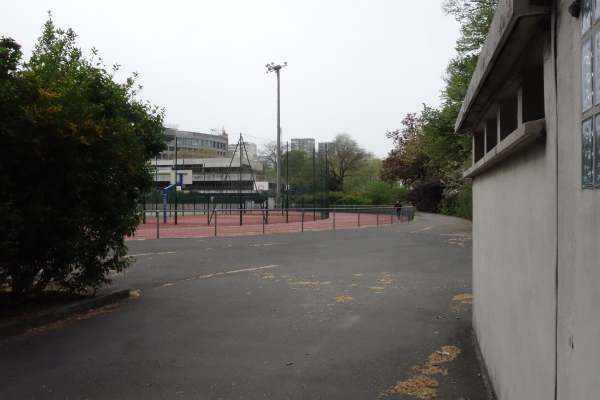 | .
| Left: The site of the L'Ouest goods yard today: 2013
This is the Stadium Emile Anthoine, looking roughly South-West.
Author's photo: 8 May 2013
|
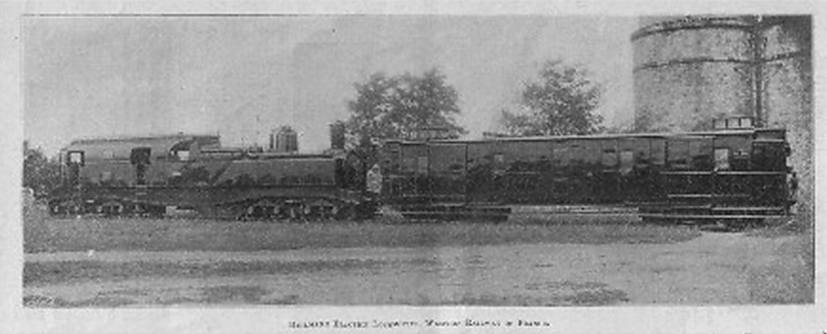 | .
| Left: Heilmann coupled to luggage/brake van
The caption at the bottom is unfortunately illegible. Finding this location will be a touch more challenging.
|
 | .
| Left: Heilmann No 8001 again
I continue to wonder why there seem to be no pictures of No 8002.
|
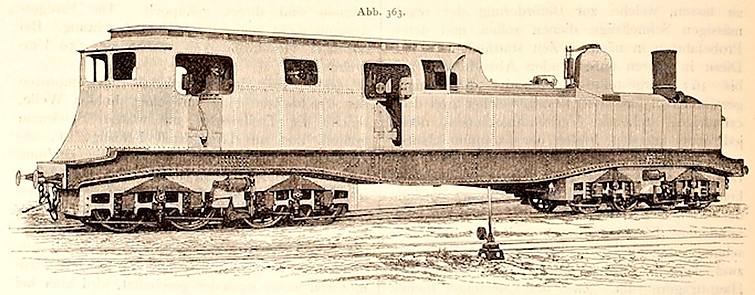 | .
| Left: Heilmann illlustration
This is clearly an illustration taken from a book written in German. "Abb." as in "Abb. 363" is short for "Abbildung", meaning "Illustration".
|








 ">
">





















